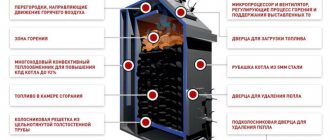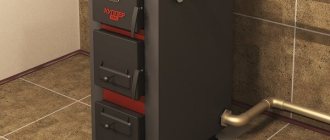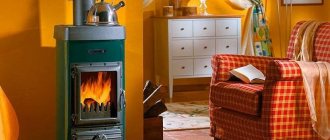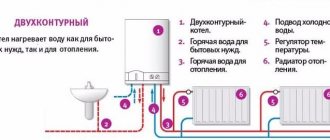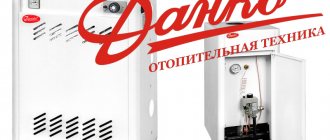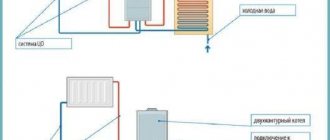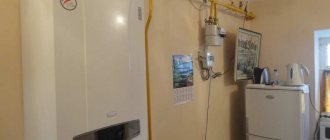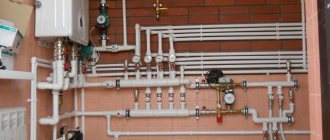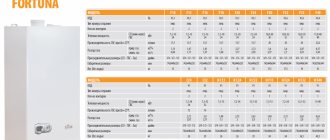Operating principle
The design features of the boilers are immediately visible from the position of the firebox door.
It is located at the top of the loading chamber. Almost the entire volume is occupied by the firebox. Another feature of “long-lasting” heat generators is the use of an ash pan. It does not serve to create traction, but performs purely utilitarian functions: through it the remains of fuel combustion products are removed. Since there is no need for an ash pan, the ash pan door closes tightly. The air enters from the chamber located at the top of the boiler. The air chamber plays the role of not only a supercharger, but also a recuperator: thanks to the design solution, the exhaust flue gases heat the walls of the chamber supplying air, and it enters the firebox heated. The damper is located at the top.
Portional air supply is provided by a distributor. The size of the tube connecting the air chamber and the distributor is adjustable due to the telescopic design. After the combustion source settles, the distributor also appears below the original level. Therefore, air constantly enters the ignition zone. After burning all the loaded coal or firewood, the distributor returns to its original position using an attached cable. Its end is brought out onto the fuel wall and reinforced with a ring. The position of the ring makes it easy to determine the fuel level. When combustion is complete, the ring jerks back down - the regulator, which portions air into the combustion chamber, takes its original position.
The design of any boiler must include a heat exchanger. In models with the Nedelka trademark, the water jacket covers the entire area of the side surfaces. Due to this arrangement of the heat exchanger, efficiency increases.
The connecting pipes supplying and receiving coolant cut into the heating system of the house, creating a closed heating circuit. The upper connecting fitting, located at the top, is the supply, through which water is poured into the boiler heat exchanger. From the lower fitting, the coolant enters the heating system by gravity. Under pressure from the upper layers. This ensures circulation.
How to make a waste oil boiler
A heating boiler is more efficient than a stove and more convenient to use, because through a radiator network it heats the entire house, and not 2-3 rooms. The second positive point: the waste oil heat generator is removed to a separate furnace room along with all the unpleasant odors that accompany this type of heating. We propose to consider step by step how to make a boiler for mining with your own hands from a gas cylinder or steel pipe.
Heater design and drawings
Craftsmen engaged in the manufacture of waste oil boilers use in practice 3 methods of burning waste:
- surface combustion with pyrolysis afterburning in a perforated pipe and secondary chamber;
- the use of Babington burners and other homemade structures;
- combustion in a flame bowl, fuel supply is organized by the drip method, air is forced.
The first option is implemented in the famous garage stove, consisting of 2 chambers connected by a vertical perforated pipe. We described the second method in detail in the corresponding publication - a Babington burner is made and built inside the body of a steel boiler that previously operated on wood.
We propose to focus on the third option - a dropper stove, converting it into a double-turn (the correct name is two-pass) water boiler. The drawing below shows the basic version of this stove, made from a Ø219 mm pipe. Why it is recommended for beginners to take the drip principle of operation of the heating unit as a basis:
- The design of oil burners is quite complex. Assembly requires some experience and financial investment (for example, for Babington you will have to buy a compressor).
- Surface combustion heaters are fire hazardous (they shoot out flames when water gets into the fuel). Equipping a miracle stove with a water jacket is not an easy task.
- Fuel consumption during surface combustion is prohibitively high - up to 2 liters of waste per hour.
- According to reviews on the forums, the drippers are reliable and can work without automation (however, the owner will have to devote some time to the boiler to get used to manual control). The unit is relatively simple to manufacture.
Liquid fuel boiler diagram
The dropper diagram shown in the drawing needs to be redone, since together with the fire tube heat exchanger the structure will not fit inside the gas cylinder - you will have to look for a large pipe with a diameter of 400 mm. The dimensions of the heat generator can be reduced without loss of power (15-20 kW) as follows:
- make an afterburner from a DN40 pipe, changing the number and diameter of the holes (more precisely indicated in the drawing);
- for the combustion chamber, take a DN150 pipe;
- weld a water jacket from two propane gas cylinders;
- heat exchanger – at least 8 flame tubes Ø32 mm;
- bowl size - according to the combustion chamber (DN150);
- height from the edge of the afterburner to the bottom of the bowl is 6.5-7 cm.
How a double-turn boiler operating on waste oil works is shown in the drawing. The difference from a simple dripper lies in the fire-tube heat exchanger located between the walls of the combustion chamber and the outer casing. Accordingly, the chimney pipe moved to the lower zone of the housing.
For reference. The boiler is called a two-pass boiler because the combustion products make 2 turns through the pipes and change the direction of movement twice before going into the chimney. There are also three-pass versions of heat generators with an upper chimney pipe.
Peculiarities
When buyers see long-burning designs, they are amazed at the size of the loading chamber. But this is not the main thing. Let's consider what causes the combustion process to stretch over a time range. Of course, not the amount of fuel, but its gradual combustion. The operating principle of Russian-made Nedelka boilers is based on gradual ignition of the fuel from top to bottom, while the lower layers remain unengulfed in flame.
The reason for gradual combustion is the regulation of air flow into the fuel chamber. It is only enough for the oxidative reactions of the upper layers. The resulting carbon dioxide protects other combustible materials from combustion. With such a portioned supply of air, a strong flame does not form at the source of fire; it does not actively spread throughout the entire volume of fuel.
During gradual combustion in a chamber of large volumes, air humidity self-regulates, so Nedelka boilers can be fueled with wood and coal without pre-drying. The fireboxes “eat” wet “food” very well.
Time-tested choice
You can list five reasons why you need to choose Nedelka boilers.
- Versatility. Boilers are not only intended for heating private homes. Their operational characteristics allow them to be installed in industrial premises: they are not fire hazardous, environmentally friendly - all doors remain hermetically closed during operation, and are safe in the event of a power outage.
- Easy to maintain: for operation you do not need to undergo special training or obtain permits; one person can easily handle it. The boilers are as safe as possible to maintain: every few days the firebox is cleaned, the ash pan is emptied, and fuel is loaded.
- Difference in modifications. different power. The heat from KO-60 is enough to heat 300 square meters, the power of KO-110 is twice as high. Recently, due to the increasing demand for high-power heat generators, cluster modifications - modular boiler houses - have been developed.
- Affordable price. The cost of domestic models ranges from 110 to 220 thousand. Imported boilers of similar design and power are much more expensive. The use of various types of low-quality fuel when operating a heat generator leads to significant cost savings.
- The durability of the boiler is due to the use of rolled metal from durable alloys. It has high fault tolerance. The warranty period is 5 years, the actual period is at least 20 years without replacement of structural elements.
Before industrial production, long-burning heat generators were made by craftsmen using handicraft methods. The model has already been tested by time and allows significant savings on fuel. It is intended not only for heating systems, but can also be used as a water heater.
You can learn how to install the Nedelka boiler from the video below.
Reviews
Reviews of long-burning solid fuel boilers Week are completely different. But there are often recurring moments. For example, people note the positive aspects of heating units; they are pleased that the boiler really burns with various cheap coals for up to 4-5 days and lives up to its name. There is no need to constantly monitor the operation of the device; you flood it and forget it. People highlight the unpretentiousness of the boiler, its safety, simple operation, and efficiency.
At the same time, some users complain about difficult and lengthy cleaning, which, together with kindling, takes 1-1.5 hours. Some are not satisfied with the price of the equipment, others are dissatisfied with the cost of electricity, the possible appearance of condensation, the lack of remote control of the boiler unit, as well as the insulation of the unit body. How many people - so many opinions.
Owner's review of the solid fuel boiler Nedelka
Take note of reviews from real users, read the technical characteristics of these heating units and make a purchasing decision. Solid fuel calving Nedelka will be an excellent solution for heating a residential or industrial premises. This is a real omnivorous cauldron for warmth and comfort, as well as freedom for other things!
Advantages of the solid fuel boiler Nedelka
All solid fuel boilers Nedelka have a 5-year manufacturer's warranty and are accompanied by free service support.
Nedelka boilers have many advantages over other heating units. For example:
- They are omnivores. This is a long-burning solid fuel boiler that perfectly burns any fuel, be it coal, wood chips, logs, sawdust, briquettes, etc. But it is worth saying that greater operating efficiency is achieved when using coal, and of varying quality! You won't need to spend money on expensive coal fuel.
- Rare service. The boiler can remain unattended by the owner for up to seven days. There is no need to move, toss, light or clean anything.
- Safety. In the event of a power outage, the boiler will slowly extinguish over 12 hours, and when turned on, it will again begin to reach the specified temperature. This is a distinct advantage of Nedelka boilers from similar heating structures; they will not boil without electricity, so safety is at a high level.
- 5 year warranty. The company guarantees proper and high-quality operation of boiler equipment for five years, while the total service life of a heating boiler, if treated with care, is at least 15 years. To extend its service life, it is enough to thoroughly clean the boiler from time to time to remove burning and soot.
- Wide power range. Solid fuel boilers Nedelka are manufactured with capacities from 5 kW to 150 kW.
- Highly efficient. High efficiency is ensured by the technology of top combustion and powerful heat removal. Most of the energy goes into the coolant, and slightly warm gas is removed into the chimney.
- Simple controls. You only need two main control buttons.
The Nedelka boiler is not picky about the quality of fuel. Coal can be anything, even dirty, dusty, wet and of poor quality.
You can read about the operating features of a long-burning pyrolysis boiler here.
Heating with a “Nedelka” boiler at a house in the Kemerovo region
The boiler was purchased to heat a 200 sq.m cottage in a village in the Kemerovo region, where in winter the temperature consistently drops to -25C. Taking into account the area of the house and the budget, we settled on the KO-60 model - the most budget-friendly in the line of boilers from this manufacturer. Since it was decided to save money, we installed and started the boiler ourselves - the kit included a detailed step-by-step manual in which all stages of the work were clearly described.
In the first days of operation of the boiler, we spent a lot of time adjusting the temperature, and as a result we came to the conclusion that it is most comfortable to live in a house at 23-25C. In winter, at a temperature of -20-25C, the boiler uninterruptedly heats the house for 2-3 days; with warming, this period increases to 5-6 days. When the fuel runs out, the boiler must be thoroughly cleaned and re-lit, this usually takes from an hour to an hour and a half.
By the way, during the week-long departure the boiler was left running and the temperature was set to 18C. By the end of the week, there was still fuel in the boiler, and the heating system in the house did not freeze. After cleaning and lighting the house quickly warmed up to a comfortable temperature.
Advantages and disadvantages
The most important quality of long-burning boilers for consumers remains the time interval between refilling the furnace.
The advantage of Nedelka boilers is, first of all, its reliability. It is largely due to the simplicity of the design solution. Another undeniable advantage is the possibility of using low-quality fuel with high humidity.
Maximum heat transfer efficiency is achieved when using the following combustible materials:
- brown coal;
- anthracite.
If they are absent, you can put in the firebox:
- pellets;
- briquettes;
- firewood - the maximum size is indicated in the operating instructions.
The disadvantages of using such boilers are their dimensions. A seven-day supply of fuel must be stored somewhere, so depending on the power, long-burning heat generators take up significant space in the house.
The second operational nuisance is a large percentage of soot in combustion products. It has the ability to settle on the walls of the firebox. When using wet fuel, condensation forms, interacting with soot, water forms carbonic acid. Therefore, soot must be cleaned off periodically. When using high-quality fuel, this problem is minimized, and the efficiency of the boiler increases. When loading construction waste into the firebox, especially resin-containing residues and wet sawdust, the volume of soot increases significantly.
Convector
Convector heaters are equipped with a powerful ceramic or metal heating element. The device works on the following principle: heated air rises upward, and cold air remains below. Such devices are silent in use, but there are exceptions for models equipped with fans. Experts recommend buying convector heaters with a temperature controller. Heating devices have the following features:
- affordable price;
- attractive appearance;
- almost silent operation;
- small dimensions;
- ease of use;
- does not warm large rooms sufficiently;
- dries out the air.
Below are the best models of convector heaters for apartments.
Maxwell MW-3471
This unit has compact dimensions and is suitable for heating rooms with a small area. The power of the device is enough to heat a room up to 12 sq.m. The heater is equipped with a minimum of functions, including protection that turns off the device if it overheats. In addition, the convector from Maxwell is equipped with a special regulator that allows you to change the temperature. The manufacturer also provided the device with convenient mounts so that it can be hung on the wall.
- indicator notifying the start of heating;
- equipped with convenient wheels that allow you to move the device around the room;
- stylish design.
- minimum additional functionality;
- unable to warm up a large room.
Resanta OK-500S
This Latvian-made heater is equipped with a heating element with minimal heating power (500 W). Therefore, such a mini-convector can be used in small rooms with an area of up to 6 square meters. m. As additional functions, the manufacturer of Resanta OK-500S offers automatic shutdown of the device when overheated and a convenient housing design. Thanks to it, moisture and dust will not be able to penetrate inside the device.
- thermostat, thanks to which the temperature in the room is at the same level;
- stylish design;
- light weight;
- ease of transportation due to wheels on the bottom;
- thanks to special fastenings it can be hung on the wall;
- low cost.
Noirot Spot E-5 750
This heater, created by a French company, has small parameters and a high degree of protection from dust and moisture. Thanks to this device, you can heat rooms with high humidity, including bathrooms. At the same time, do not forget about safety measures (install the French convector away from the water source). The manufacturer offers several options for the Noirot Spot E-5 750 for the consumer to choose from: with a power of 0.5, 1.5 and 2 kW.
- silent operation;
- remembering the set temperature settings in case of sudden shutdown;
- safety in operation;
- high-quality assembly.
Scarlett SCA H VER2 1500
This Russian-Chinese convector is notable for its ergonomic design and compact parameters. The relatively small power of the Scarlett SCA H VER2 1500 (1.5 kW) allows you to heat a room up to 16 sq.m. The device is equipped with legs, thanks to which it is well fixed to the floor and mechanical temperature switches.
- can warm up one average room;
- equipped with fastenings for wall mounting;
- ease of use;
- compact dimensions;
- affordable price.
Boiler installation
To locate the boiler, select a warm non-residential room with an area of more than 5 sq.m., in which you will have free access to the boiler from three sides. The room must be isolated from the residential part of the house so that odors from the boiler room do not penetrate into the rooms. In order for the boiler to burn well, the boiler room must have natural ventilation. Ideally, the boiler should be installed on a foundation and should not be close to flammable materials, but if this is not possible, then a fire-retardant gasket must be installed under the boiler and in front of it.
Next, the boiler is installed into the heating system that is already installed in the house. It is necessary to carefully seal all connections between the boiler and the heating system and fix the temperature sensor on the supply pipe to the system. The most convenient way to do this is with the help of a thermal cover, which is already included in the equipment set for the boiler. Install the controller and fan and make sure the fan damper lifts freely.
After installation, it is necessary to fill the system and boiler with coolant, place cardboard or firewood on the boiler grate and pour coal into the boiler. Next, check that all hatches are hermetically closed, set the temperature to no lower than 60 degrees and go outside to check if smoke is coming from the chimney. After half an hour, open the drain hole - during the first start, a lot of condensation will form, it needs to be drained.
